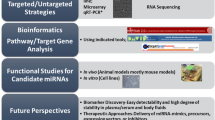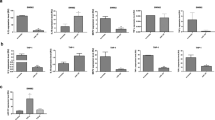Abstract
Familial Mediterranean fever (FMF) is an inherited autoinflammatory disorder that can result in attacks with accompanying recurrent episodes of fever, serositis, and skin rash. MiRNAs are demonstrated to be associated with a number of other diseases; however, no comprehensive study has revealed its association with FMF disease. The aim is to investigate the role of microRNAs in FMF. We included 51 patients with genetically diagnosed FMF who had clinical symptoms and 49 healthy volunteers. Fifteen miRNAs that were found to be associated with autoinflammatory diseases and have a part in immune response were evaluated. The expression levels of 11 miRNAs (miR-125a, miR-132, miR-146a, miR-155, miR-15a, miR-16, miR-181a, miR-21, miR-223, miR-26a, and miR-34a) in the patient group were significantly low, compared with the control group (p < 0.05). The patient group was analyzed and compared within itself, and the expression levels of 5 miRNAs (miR-132, miR-15a, miR-181a, miR-23b, miR-26a) in the patients who took colchicine seemed to have increased and levels of 5 miRNAs (miR-146a, miR-15a, miR-16, miR-26a, miR-34a) in the patients who took colchicine were significantly lower (p < 0.05). Furthermore, the attack patients were compared with the control group, and their expression levels of 4 miRNAs (miR-132, miR-15a, miR-21, miR-34a) were significantly lower (p < 0.05). Levels of 9 miRNAs (miR-132, miR-146a, miR-15a, miR-16, miR-181a, miR-21, miR-223, miR-26a, miR-34a) in non-attack patients decreased significantly (p < 0.05). Our study demonstrates that miRNAs could be effective in the pathogenesis of FMF.


Similar content being viewed by others
Change history
07 January 2019
The name of the last author of this article was incorrectly presented as “Cogulu Ozgur” this should have been “Ozgur Cogulu”.
References
Peru H, Altun B, Doğan M, Kara F, Elmaci AM, Oran B (2008) The evaluation of carotid intima-media thickness in children with familial Mediterranean fever. Clin Rheumatol 27(6):689–694. https://doi.org/10.1007/s10067-007-0764-1
Zadeh N, Getzug T, Grody WW (2011) Diagnosis and management of familial Mediterranean fever: integrating medical genetics in a dedicated interdisciplinary clinic. Genet Med 13(3):263–269. https://doi.org/10.1097/GIM.0b013e31820e27b1
Papin S, Cuenin S, Agostini L, Martinon F, Werner S, Beer HD, Grütter C, Grütter M, Tschopp J (2007) The SPRY domain of Pyrin, mutated in familial Mediterranean fever patients, interacts with inflammasome components and inhibits proIL-1beta processing. Cell Death Differ 14(8):1457–1466. https://doi.org/10.1038/sj.cdd.4402142
Chae JJ, Cho YH, Lee GS, Cheng J, Liu PP, Feigenbaum L et al (2011) Gain-of-function pyrin mutations induce NLRP3 protein-independent interleukin-1β activation and severe autoinflammation in mice. Immunity 34(5):755–768
de Torre-Minguela C, Mesa Del Castillo P, Pelegrín P (2017) The NLRP3 and pyrin inflammasomes: implications in the pathophysiology of autoinflammatory diseases. Front Immunol 8:43
Ben-Chetrit E, Levy M (1998) Familial Mediterranean fever. Lancet 351(9103):659–364. https://doi.org/10.1016/S0140-6736(97)09408-7
Samuels J, Aksentijevich I, Torosyan Y, Centola M, Deng Z, Sood R, Kastner DL (1998) Familial Mediterranean fever at the millennium. Clinical spectrum, ancient mutations and a survey of 100 American referrals to the National Institutes of Health. Medicine 77(4):268–297. https://doi.org/10.1097/00005792-199807000-00005
Heller H, Shoar E, Gafni J, Heller J (1961) Amyloidosis in FMF: an independent genetically determined character. Arch Intern Med 107(4):539–550. https://doi.org/10.1001/archinte.1961.03620040065007
Rogers DB, Shohat M, Petersen CM, Bickal J, Congleton J, Schwabe AD et al (1989) Familial Mediterranean fever in Armenians: autosomal recessive inheritance with high gene frequency. Am J Med Genet 34(2):168–172. https://doi.org/10.1002/ajmg.1320340206
Ben-Chetrit E, Backenroth R (2001) Amyloidosis induced, end stage renal disease in patients with familial Mediterranean fever is highly associated with point mutations in the MEFV gene. Ann Rheum Dis 60(2):146–149. https://doi.org/10.1136/ard.60.2.146
Mansour I, Delague V, Cazeneuve C, Dodé C, Chouery E, Pêcheux C, Medlej-Hashim M, Salem N, ElZein L, Levan-Petit I, Lefranc G, Goossens M, Delpech M, Amselem S, Loiselet J, Grateau G, Mégarbane A, Naman R (2001) Familial Mediterranean fever in Lebanon: mutation spectrum, evidence for cases in Maronites, Greek orthodoxes, Greek catholics, Syriacs and Chiites and for an association between amyloidosis and M694V and M694I mutations. Eur J Hum Genet 9(1):51–55. https://doi.org/10.1038/sj.ejhg.5200574
Tekin M, Yalcinkaya F, Cakar N, Akar N, Misirlioglu M, Tastan H et al (2000) MEFV mutations in multiplex families with familial Mediterranean fever: is a particular genotype necessary for amyloidosis? Clin Genet 57(6):430–434
Daniel LK (1997) İntermittent and periodic arthritic syndromes. In: Kopman JK (ed) Arthritis and allied conditions: a textbook of rheumatology, 13 edn. Williams and Wilkins Comp., Philadelphia, pp 1279–1306
Baykal Y, Saglam K, Yilmaz MI, Taslipinar A, Akinci SB, Inal A et al (2003) Serum sIL-2r, IL-6, IL-10 and TNF-alpha level in familial Mediterranean fever patients. Clin Rheumatol 22(2):99–101. https://doi.org/10.1007/s10067-002-0682-1
Korkmaz C, Ozdogan H, Kasapcopur O, Yazıcı H (2002) Acute phase response in familial Mediterranean fever. Ann Rheum Dis 61(1):79–81. https://doi.org/10.1136/ard.61.1.79
Ben-Cherit E, Bergmann S, Sood R (2006) Mechanism of the antiinflammatory effect of colchicine in rheumatic diseases :a possible new outlook through microarray analysis. Rheumatology 45(3):274–282. https://doi.org/10.1093/rheumatology/kei140
Álvarez-Errico D, Vento-Tormo R, Ballestar E (2017) Genetic and epigenetic determinants in autoinflammatory diseases. Front Immunol 22(8):318
Bartel DP (2004) MiRNAs: genomics, biogenesis, mechanism, and function. Cell 116(2):281–297. https://doi.org/10.1016/S0092-8674(04)00045-5
Lee RC, Feinbaum RL, Ambros V (1993) The C. elegans heterochronic gene lin-4 encodes small RNAs with antisense complementarity to lin-14. Cell 75(5):843–854. https://doi.org/10.1016/0092-8674(93)90529-Y
Jackson RJ, Standart N (2007) How do miRNAs regulate gene expression? Sci STKE 1:367
Cobb BS, Hertweck A, Smith J, O'Connor E, Graf D, Cook T, Smale ST, Sakaguchi S, Livesey FJ, Fisher AG, Merkenschlager M (2006) A role for Dicer in immune regulation. J Exp Med 203(11):2519–2527. https://doi.org/10.1084/jem.20061692
Muljo SA, Ansel KM, Kanellopoulou C, Livingston DM, Rao A, Rajewsky K (2005) Aberrant T cell differentiation in the absence of Dicer. J Exp Med 202(2):261–269. https://doi.org/10.1084/jem.20050678
Livneh A, Langevitz P, Zemer D, Zaks N, Kees S, Lidar T, Migdal A, Padeh S, Pras M (1997) Criteria for the diagnosis of familial Mediterranean fever. Arthritis Rheum 40(10):1879–1885. https://doi.org/10.1002/art.1780401023
Tone Y, Toma T, Toga A, Sakakibara Y, Wada T, Yabe M, Kusafuka H, Yachie A (2012) Enhanced exon 2 skipping caused by c.910G>A variant and alternative splicing of MEFV genes in two independent cases of familial Mediterranean fever. Mod Rheumatol 22(1):45–51. https://doi.org/10.3109/s10165-011-0461-4
Jung SH, Young SS (2012) Power and sample size calculation for microarray studies. J Biopharm Stat 22(1):30–42. https://doi.org/10.1080/10543406.2010.500066
Stanczyk J, Pedrioli DM, Brentano F, Sanchez-Pernaute O, Kolling C, Gay RE et al (2008) Altered expression of MiRNA in synovial fibroblasts and synovial tissue in rheumatoid arthritis. Arthritis Rheum 58(4):1001–1009. https://doi.org/10.1002/art.23386
Faraoni I, Antonetti FR, Cardone J, Bonmassar E (2009) miR-155 gene: a typical multifunctional microRNA. Biochim Biophys Acta 1792(6):497–505. https://doi.org/10.1016/j.bbadis.2009.02.013
Pauley KM, Satoh M, Chan AL, Bubb MR, Reeves WH, Chan EK (2008) Upregulated miR-146a expression in peripheral blood mononuclear cells from rheumatoid arthritis patients. Arthritis Res Ther 10(4):R101. https://doi.org/10.1186/ar2493
Li X, Kroin JS, Kc R, Gibson G, Chen D, Corbett GT, Pahan K, Fayyaz S, Kim JS, van Wijnen AJ, Suh J, Kim SG, Im HJ (2013) Altered spinal miRNA-146a and the miRNA-183 cluster contribute to osteoarthritic pain in knee joints. J Bone Miner Res 28(12):2512–2522. https://doi.org/10.1002/jbmr.2002
Tang Y, Luo X, Cui H, Ni X, Yuan M, Guo Y, Huang X, Zhou H, de Vries N, Tak PP, Chen S, Shen N (2009) MiRNA-146A contributes to abnormal activation of the type I interferon pathway in human lupus by targeting the key signaling proteins. Arthritis Rheum 60(4):1065–1075. https://doi.org/10.1002/art.24436
Wang G, Tam LS, Li EK, Kwan BC, Chow KM, Luk CC et al (2010) Serum and urinary cell-free MiR-146a and MiR-155 in patients with systemic lupus erythematosus. J Rheumatol 37(12):2516–2522. https://doi.org/10.3899/jrheum.100308
Bauernfeind F, Rieger A, Schildberg FA, Knolle PA, Schmid-Burgk JL, Hornung V (2012) NLRP3 inflammasome activity is negatively controlled by miR-223. J Immunol 189(8):4175–4181. https://doi.org/10.4049/jimmunol.1201516
Li T, Morgan MJ, Choksi S, Zhang Y, Kim YS, Liu ZG (2010) MiRNAs modulate the noncanonical transcription factor NF-kappaB pathway by regulating expression of the kinase IKKalpha during macrophage differentiation. Nat Immunol 11(9):799–805. https://doi.org/10.1038/ni.1918
Fulci V, Scappucci G, Sebastiani GD, Giannitti C, Franceschini D, Meloni F, Colombo T, Citarella F, Barnaba V, Minisola G, Galeazzi M, Macino G (2010) miR-223 is overexpressed in T-lymphocytes of patients affected by rheumatoid arthritis. Hum Immunol 71(2):206–211. https://doi.org/10.1016/j.humimm.2009.11.008
Murata K, Yoshitomi H, Tanida S, Ishikawa M, Nishitani K, Ito H et al (2010) Plasma and synovial fluid miRNAs as potential biomarkers of rheumatoid arthritis and osteoarthritis. Arthritis Res Ther 12:R86
Kim SW, Ramasamy K, Bouamar H, Lin AP, Jiang D, Aguiar RC (2012) MiRNAs miR-125a and miR-125b constitutively activate the NF-kappaB pathway by targeting the tumor necrosis factor alphainduced protein 3 (TNFAIP3, A20). Proc Natl Acad Sci U S A 109(20):7865–7870. https://doi.org/10.1073/pnas.1200081109
Zhao X, Tang Y, Qu B, Cui H, Wang S, Wang L, Luo X, Huang X, Li J, Chen S, Shen N (2010) MiRNA-125a contributes to elevated inflammatory chemokine RANTES levels via targeting KLF13 in systemic lupus erythematosus. Arthritis Rheum 62(11):3425–3435. https://doi.org/10.1002/art.27632
Lashine YA, Seoudi AM, Salah S, Abdelaziz AI (2011) Expression signature of miRNA 181-a reveals its crucial role in the pathogenesis of paediatric systemic lupus erythematosus. Clin Exp Rheumatol 29(2):351–357
Okuhara A, Nakasa T, Shibuya H, Niimoto T, Adachi N, Deie M, Ochi M (2012) Changes in miRNA expression in peripheral mononuclear cells according to the progression of osteoarthritis. Mod Rheumatol 22(3):446–457. https://doi.org/10.3109/s10165-011-0536-2
Tufekci KU, Oner MG, Genc S, Genc K (2011) MiRNAs and multiple sclerosis. Autoimmun Dis 2011:1–27. https://doi.org/10.4061/2011/807426
Gandhi R, Healy B, Gholipour T, Egorova S, Musallam A, Shuja M et al (2013) Circulating miRNAs as biomarkers for disease staging in multiple sclerosis. Ann Neurol 73(6):729–740. https://doi.org/10.1002/ana.23880
Niederer F, Trenkmann M, Ospelt C, Karouzakis E, Neidhart M, Stanczyk J, Kolling C, Gay RE, Detmar M, Gay S, Jüngel A, Kyburz D (2012) Down-regulation of miRNA-34a* in rheumatoid arthritis synovial fibroblasts promotes apoptosis resistance. Arthritis Rheum 64(6):1771–1779. https://doi.org/10.1002/art.34334
Zhang R, Tian A, Wang J, Shen X, Qi G, Tang Y (2015) miR26a modulates Th17/Treg balance in the EAE model of multiple sclerosis by targeting IL6. NeuroMolecular Med 17(1):24–34. https://doi.org/10.1007/s12017-014-8335-5
Zhu S, Pan W, Song X, Liu Y, Shao XR, Tang YJ et al (2012) The miRNA miR-23b suppresses IL-17-associated autoimmune inflammation by targeting TAB 2, TAB 3 and IKK-alpha. Nat Med 18(7):1077–1086. https://doi.org/10.1038/nm.2815
Wada T, Toma T, Matsuda Y, Yachie A, Itami S, Taguchi Y et al (2017) Microarray analysis of circulating microRNAs in familial Mediterranean fever. Mod Rheumatol 6:1–18
Latsoudis H, Mashreghi MF, Grün JR, Chang HD, Stuhlmüller B, Repa A, Gergiannaki I, Kabouraki E, Vlachos GS, Häupl T, Radbruch A, Sidiropoulos P, Doukoumetzidis K, Kardassis D, Niewold TB, Boumpas DT, Goulielmos GN (2017) Differential expression of miR-4520a associated with pyrin mutations in familial Mediterranean fever (FMF). J Cell Physiol 232(6):1326–1336. https://doi.org/10.1002/jcp.25602
Author information
Authors and Affiliations
Corresponding author
Ethics declarations
The current study received ethical approval from the university’s departmental ethics committee.
Disclosures
None.
Additional information
The original version of this article was revised: The name of the second author of this article was incorrectly presented as “Cogulu Ozgur” this should have been “Ozgur Cogulu".
Rights and permissions
About this article
Cite this article
Hortu, H.O., Karaca, E., Sozeri, B. et al. Evaluation of the effects of miRNAs in familial Mediterranean fever. Clin Rheumatol 38, 635–643 (2019). https://doi.org/10.1007/s10067-017-3914-0
Received:
Revised:
Accepted:
Published:
Issue Date:
DOI: https://doi.org/10.1007/s10067-017-3914-0




